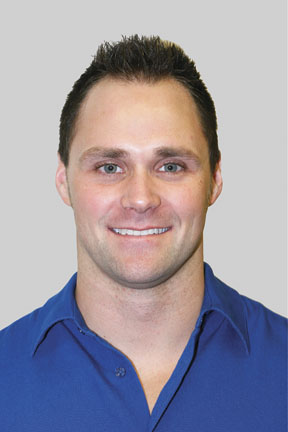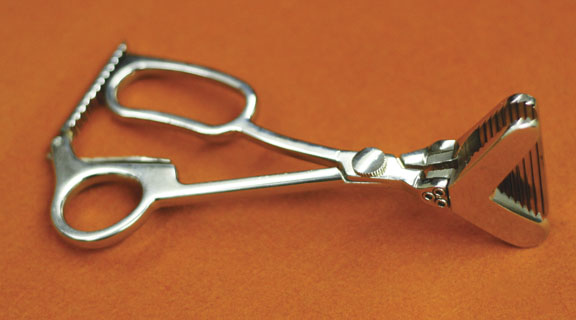Bones about it: recent Knox grad
invents tool to revolutionize knee replacement surgery
by Mike Kroll
School
projects are a hallmark of American education. Who among us didn't complete
multiple dioramas in grade school or a science fair project in junior high?
While the educational value of such projects runs the spectrum from just plain
fun to enlightened epiphany most are hardly memorable weeks later and very few
affect the lives of thousands of people. One recent Knox College graduate may
well illustrate that rare example of a honors project promising longterm
positive consequences for medicine.
 Chris Snell
of Alexis is not your typical recent college graduate. For one thing, the tall,
athletic-looking young man with short dark hair and a comfortable air of
confidence about himself is a few years older that the typical college graduate
and he remains at Knox working as laboratory coordinator in the Biology
department. For another he is well on his way to receiving a patent for a
medical device he invented as his Knox honor project that has already in
regular use by local orthopedic surgeon Steven Potaczek.
Chris Snell
of Alexis is not your typical recent college graduate. For one thing, the tall,
athletic-looking young man with short dark hair and a comfortable air of
confidence about himself is a few years older that the typical college graduate
and he remains at Knox working as laboratory coordinator in the Biology
department. For another he is well on his way to receiving a patent for a
medical device he invented as his Knox honor project that has already in
regular use by local orthopedic surgeon Steven Potaczek.
At first
glance Snell's bone clamp looks like just another stainless steel surgical
instrument but it may just be the prototype for a line of custom-designed bone
clamps that will be used by surgeons across the world and the start of a career
for this 2008 Knox College graduate. It has been mere weeks since Snell began
the patent process but it may well take three years to finally receive the
patent. In that time this young man expects to be developing additional devices
and earning royalty payments from the licensed manufacture and sale of his bone
clamp.
"This has
really been an amazing experience," said Snell. "I have worked really hard on
this project but there is no way it could have happened without the
extraordinary support and assistance I have received from Knox College, Dr.
Potaczek and especially [Knox president] Roger Taylor. So many people have
aided me so much in making this project successful. There is no question that
without their help I could never have accomplished this."
Talking to
Chris you can't help but come away impressed by how unassumingly bright he is
as well as his ambitious, clear-eyed plan for his future. Only a few years ago
Chris was, by his own description, digging muddy ditches and laying conduit as
an apprentice union electrician. "I spent nearly five years in the electrical
union apprentice program and was learning a good trade that could earn me a
solid living but I just wasn't enjoying the work. I felt I was spending too
much time on comparatively menial tasks that didn't offer me the mental
challenges I need. That is why I applied to Knox and began on the pre-med track
that eventually led me to this point in my life."
A critical
component of Knox's pre-med program is serving a medical-related internship.
Snell was assigned to OSF St. Mary Medical Center and the Galesburg Clinic
where he met Potaczek during a surgical rotation.
"I was
watching Dr. Potaczek in surgery doing a knee replacement and noticed that he
seemed to be laboring to properly hold the bone as he removed part of it. After
he was finished and we were talking about the operation I commented on this and
said I thought the instrument he was using didn't seem to work too well. He
agreed and told me that he had never found an bone clamp that was properly
designed for this task and really wished someone would come up with such a
device."
Such was Snell's inspiration but as he quickly
learned developing a new medical device or instrument is a long, complicated
and costly process. The young man had two major assets at his disposal however,
Potaczek and Knox College. The former worked very closely with Snell to help
determine what was needed and to accommodate a variety of different bone sizes
and committed to actually using the prototype instrument n surgery to test it
in action. Knox supported the endeavor financially and by helping Snell
fabricate the prototypes out of surgical-quality stainless steel. Taylor took a
very personal interest in Chris and his project and directly put him in touch
with a Milwaukee law firm specializing in patents.
In the
acknowledgment of his Knox Honors Thesis Snell wrote of Potaczek: "If he
wouldn't have sat down with me, over a year ago, to patiently answer my
questions and discuss his surgeries, I would not have had the opportunity to
pursue this project." Additionally he thanked Knox professors Judy Thorn and
Linda Dybas (Biology) and Charles Schultz (Physics) who very actively served on
his committee.
The human body and
its component parts are amazing in their variety, particularly in size and
shape. This presents unique challenges to surgeon who need specialized tools to
perform their work. As surgical techniques advance or change there is a
constant need for new variations on established instruments.
"A better surgical
instrument can be a real advantage to both the surgeon and patient," explained
Snell. "In the case of the clamps previously used during knee replacement
surgery there just wasn't one specifically designed to grasp and hold the tibia
enabling fast and easy removal of the portion at the knee joint. Often times a
surgeon would find existing tools slipping or breaking the portion of the bone
being removed and generally making the procedure take longer. My tool maximizes
the surface contact area with the bone allowing the surgeon to apply uniform
pressure with the use on just one hand. This greatly speeds up the surgery and
reduces almost completely the problem of retrieving broken fragmentation from
the removed section of bone."
The tibia is
commonly known as the shin bone. It is the second largest bone in the human
body and the larger of two bones in the lower leg that joins with the femur
(the largest human bone) at the knee joint. In a total knee replacement the top
portion of the tibia must be removed to permit attachment of the man-made
replacement knee joint assembly. Snell's tool was designed just for this
purpose and even permits the surgeon to replace the two clamping surfaces to
suit the size of the patient's tibia.
Despite all the
support Knox College provided Snell during this project, including a
not-insubstantial financial commitment, college officials signed an agreement
declaring him sole owner of the invention and patent. "They told me that this
was the first time a Knox student had completed a project like this that led to
a patent and Roger Taylor took a special personal interest in both me and my
project. I will forever be grateful and if this becomes a financial success I
intend to share some of that with Knox."
When he
began this project Snell had an ambitious goal in mind. He wanted to provide a
better surgical outcome for patient and physician alike. If preliminary results
are any indication he will succeed. Potaczek now regularly uses one of the
three prototype clamps Snell has fabricated and at least one other orthopedic
surgeon in Peoria was very impressed when he used a borrowed copy of the
clamp The next step for Snell will
be contacting firms that manufacture and sell surgical instruments in an
attempt to license his design and see it sold nationally or internationally. He
hasn't given up on his desire to attend medical school but he now sees his
interest in developing additional medical instruments as superseding his desire
to practice medicine. In any event he seems to be a young man with a very
bright future ahead and yet another extraordinary Knox College graduate.
11/13/08